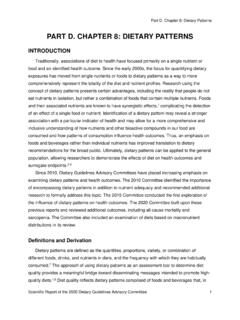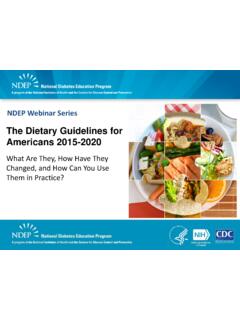Transcription of Childhood Obesity - GOV.UK
1 August 2016 Childhood Obesity A Plan for Action 2 DH ID box Title: Childhood Obesity : A Plan for Action Author: HM Government 10800 Document Purpose: Policy Publication date: 08/2016 Contact details: You may re-use the text of this document (not including logos) free of charge in any format or medium, under the terms of the Open Government Licence. To view this licence, visit Crown copyright 2016 Published to , in PDF format only. 3 Introduction Today nearly a third of children aged 2 to 15 are overweight or obesei,1 and younger generations are becoming obese at earlier ages and staying obese for Reducing Obesity levels will save lives as Obesity doubles the risk of dying Obese adults are seven times more likely to become a type 2 diabetic than adults of a healthy weight4 which may cause blindness or limb amputation.
2 And not only are obese people more likely to get physical health conditions like heart disease, they are also more likely to be living with conditions like depression. 5, 6 The economic costs are great, too. We spend more each year on the treatment of Obesity and diabetes than we do on the police, fire service and judicial system It was estimated that the NHS in England spent billion on overweight and Obesity -related ill-health in 2014 The burden is falling hardest on those children from low-income backgrounds. Obesity rates are highest for children from the most deprived areas and this is getting Children aged 5 and from the poorest income groups are twice as likely to be obese compared to their most well off counterparts and by age 11 they are three times as Obesity is a complex problem with many drivers, including our behaviour, environment, genetics and culture.
3 However, at its root Obesity is caused by an energy imbalance: taking in more energy through food than we use through activity. Physical activity is associated with numerous health benefits for children, such as muscle and bone strength, health and fitness, improved quality of sleep and maintenance of a healthy There is also evidence that physical activity and participating in organised sports and after school clubs is linked to improved academic ,13 Long-term, sustainable change will only be achieved through the active engagement of schools, communities, families and individuals. We aim to significantly reduce England s rate of Childhood Obesity within the next ten years.
4 We are confident that our approach will reduce Childhood Obesity while respecting consumer choice, economic realities and, ultimately, our need to eat. Although we are clear in our goals and firm in the action we will take, the launch of this plan represents the start of a conversation, rather than the final word. i A child s BMI is based on weight for height defined as weight in kilograms divided by the height in metres squared (kg/m2). To take into account growth patterns by age and gender, a children s BMI is compared with BMI centiles on published growth charts. Children with a BMI above the 98th centile are considered clinically obese.
5 For population monitoring those above the 95th centile are classed as obese. Childhood Obesity 4 Introducing a soft drinks industry levy Our children are consuming too many calories - and, in particular, too much Teenagers in England are the biggest consumers of sugar-sweetened drinks in The Scientific advisory Committee on Nutrition (SACN) recently concluded that sugar consumption increases the risk of consuming too many calories, the risk of tooth decay, and that consumption of sugar sweetened beverages is associated with increased risk of type 2 diabetes and linked to higher weight in A single 330ml can of a soft drink with added sugar (which can contain as much as 35g of sugar)
6 , may instantly take a child over their maximum recommended daily intake of sugar. As a first major step towards tackling Childhood Obesity , we will be introducing a soft drinks industry levy across the UK. In England, the revenue from the levy will be invested in programmes to reduce Obesity and encourage physical activity and balanced diets for school age children. This includes doubling the Primary PE and Sport Premium and putting a further 10 million a year into school healthy breakfast clubs to give more children a healthier start to their day. The Barnett formula will be applied to spending on these new initiatives in the normal way.
7 This is a levy on producers and importers, and not on consumers, and is designed to encourage producers to reduce the amount of sugar in their products and to move consumers towards healthier alternatives. We have given producers and importers two years to lower the sugar in their drinks so that they won t face the levy if they take action. Many manufacturers have already taken steps to reduce the overall levels of added sugar in their drinks, but the levy will create stronger incentives for action. Alongside this plan, HM Treasury are consulting on the technical detail of the soft drinks industry levy over the summer, and will legislate in the Finance Bill 2017.
8 Taking out 20% of sugar in products Evidence shows that slowly changing the balance of ingredients in everyday products, or making changes to product size, is a successful way of improving ,18 This is because the changes are universal and do not rely on individual behaviour change. We will therefore launch a broad, structured sugar reduction programme to remove sugar from the products children eat most. All sectors of the food and drinks industry will be challenged to reduce overall sugar across a range of products that contribute to children s sugar intakes by at least 20% by 2020, including a 5% reduction in year one.
9 This can be achieved through reduction of sugar levels in products, reducing portion size or shifting purchasing towards lower sugar alternatives. This programme will be led and run by Public Health England (PHE) and will apply to all sectors of industry retailers, manufacturers and the out of home sector ( restaurants, takeaways and caf s) and to all foods and drinks that contribute to children s sugar intakes, including those aimed at very young children. The programme will initially focus on the nine categories that make the largest contributions to children s sugar intakes: breakfast cereals, yoghurts, 5 biscuits, cakes, confectionery, morning goods ( pastries), puddings, ice cream and sweet Work will then move on to cover the remaining relevant foods and drinks, including any products that may be out of scope of the soft drinks industry levy, for example, milk-based drinks.
10 The sugar reduction programme will also work to reduce the sugar content of product ranges explicitly targeted at babies and young PHE will advise Government on setting sugar targets per 100g of product and calorie caps for specific single serving products. The 4-year, category-specific targets for the nine initial categories will be published in March 2017. Progress will be measured on the basis of reductions in the sales weighted average sugar content per 100 grams of food and drink, reductions in portion size so that these contain less sugar, or a clear sales shift towards lower sugar alternatives. iv To ensure that the achievement matches expectations, progress will be reviewed by PHE who will publish interim reports on progress every 6 months.















